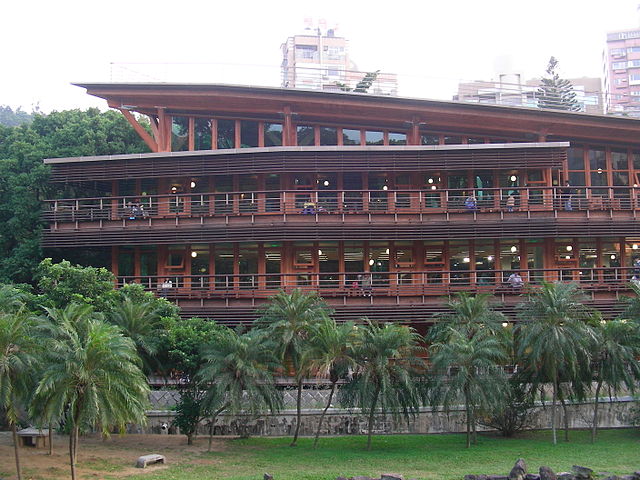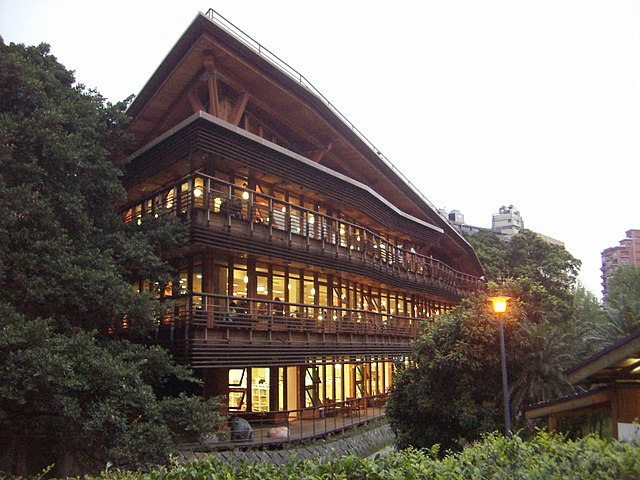The Taipei Public Library, Beitou Branch, Taiwan
The Beitou District is in northern Taipei City, Taiwan. Beitou is a mountainous region with rivers and hot springs. Known as Taiwan’s greenest building, the Beitou Branch of the Taipei Public Library opened in 2006. It was designed by Bio Architecture Formosana, a design firm formed in 1999 to focus on buildings that coexist with nature. Highly concerned with environmental issues, the designers use renewable resources and eco-friendly materials. The Beitou Public Library uses sustainable methods such as solar energy, rain water collection, solar energy panels on the roof, and open windows. It received the highest rating in the Taiwanese government’s EEWH system which emphasizes ecology, energy saving, waste reduction, and health. The wood used to build the Beitou Library was imported from North American forests, since logging has been banned in Taiwan, and trees from Southeast Asia are not cut down in a sustainable manner, causing widespread deforestation. The unusual shape of the building makes it look like a tree house and a sailing ship. Its welcoming balconies invite readers who wish to enjoy the surrounding greenery.
Working in the environment.
Since Taiwan has a hot and humid climate with a large insect population, the wooden walls needed to be protected. Instead of using chemicals that are bad for the environment, natural wood oils were used. The library has large windows, reducing the need for electric lighting inside. When opened, windows provide a draft that replaces electric fans and air-conditioning to some extent. Solar energy panels on the roof save a considerable amount of money in electric costs, and part of the roof is also covered with soil that keeps warmth in during the winter and absorbs some of the heat in the summer. Plants grow naturally on the roof, which is good for air quality, but are not tended or watered apart from rainfall. This abundant rainfall is captured by the sloping roof, and is used for indoor plumbing purposes. The Beitou Library is also close to public transportation, reducing the need for visitors to use cars. Although initial costs for green buildings can be from 10 to 30 percent more than usual polluting buildings, in the long range they can save money. Plus, innovative and attractive buildings such as the Beitou Branch of the Taipei Public Library attract tourists and add to the local economy.

How it was planned.
A previous, more traditional library building had stood in the same place since 1987, but required so many renovations that it was closed in 2000 and demolished two years later.
The location, in the picturesque Beitou Park, some distance away from the cement and traffic of downtown Taipei, was taken into account. Since the new library would be next to Beitou creek and close to the Beitou Hot Spring Museum, the Taipei Public Library system decided to celebrate these features, also including a large selection of books on nature and econology in the library’s collection. The Beitou branch would be a green building built on the principles of ecological sustainability. Since its opening, the Beitou Branch has won numerous design awards.

Thailand and Taiwan
As many Thai people know, farang sometimes confuse Thailand and Taiwan. If you say you are from Thailand, a farang may ask, “You mean Taiwan?” This is usually because the farang does not often think about either Thailand or Taiwan and so is not accustomed to hearing either country mentioned in conversation. Also some Thai people do not pronounce both syllables in the word Thailand loudly and clearly enough. If you say Thai loudly and land softly, the farangs may not hear or understand you, and if they only hear the sound Thai, they may guess you mean Taiwan. So always be sure to say land as loudly and clearly as Thai whenever you say Thailand, and carefully pronounce the final consonants. If you leave out the final d, then Thailand can sound like Thailan, which is similar in sound to Taiwan.
Usually the confusion can be resolved if you add further details, such as that you are from Bangkok or Chiang Mai, but it reminds us that Thailand and Taiwan do share some other things in common. Even if as yet Thai people are not generally as aware or concerned about preserving nature and especially trees as the Taiwanese are, the Information Division of the Taipei Economic and Cultural Office in Thailand works to improve mutual understanding between the two countries. According to their website, they especially emphasize Taiwan’s “democratic development, economic liberalization, social openness and cultural diversity.” Perhaps as a result, last year the Taiwanese Embassy in Thailand announced that the Taiwan-Thailand trade and investment relationship was on the rise. In 2013, bilateral trade was around 11 billion USD.

As of June 2014, Taiwanese businesses had invested over $13.5 billion USD in Thailand. There are more than 3,000 Taiwanese companies in Thailand dealing in electronics, metal products, machinery, chemicals, and paper. The Taiwanese Embassy states that Taiwan and Thailand “put innovation as the heart of economic development in the future.” If part of this innovation is the kind of ecological awareness that made possible the construction of the Beitou Public Library, then Thailand may definitely benefit from this example in the future, if environmentally informed local architecture firms are given projects to design.
Lasting friendship
The ongoing need for a useful relationship between Thailand and Taiwan is shown by the fact that despite political changes in Taipei, there has been since 1975 a version of the Taipei Economic and Cultural Office in Thailand, although under different names. In 1975, it was called China Airlines, Representative Office, which was renamed in 1980 as the Far East Trade Office, and yet again in 1991 as the Taipei Economic and Trade Center. The following year some Taiwanese experts decided it would be better to call it the Taipei Economic and Trade Office, and so the name was altered once more. Only in 1999 did it receive the name which it still bears today, the Taipei Economic and Cultural Office in Thailand. The Cultural Division of the Taipei Economic and Cultural Office in Thailand is located in the Empire Tower on South Sathorn Road, Bangkok.
(Images courtesy of the Taipei Public Library, Beitou Branch and Wikimedia Commons.)


